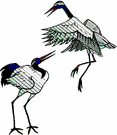
Tonight I returned to the location where I saw the creche wondering if the full flock would be back in that area or if they take the fledglings to another site for the night. The fledglings weren't in the area I saw them earlier today (this pic is of one of those fledglings-grayish plumage is somewhat visible). I found the main flock about a half mile away flying between juniper trees (just a little lower in elevation and no pinyon trees). They were making their contact calls (Rawk or Krawk) as they moved about, probably foraging (boy, there are junper berries on trees in this area).
The flock flew in closer to the road where I was parked and it quickly became apparent that this was a reasonable size flock of about 75 members. At one point 30-40 birds flew into one large juniper and it was like that tree was alive. As if one had given the signal, they all flew off together back towards the area where I had seen the creche today.
Since there are so many members in this flock, it wouldn't seem that the few fledglings in the creche I saw today would be all the offspring of this group. Maybe these are the last of the fledglings that are still not independent.
The area they are in is good habitat--pinyons in the upper sections, junipers throughout, mountain mahogany shrubs, tree cholla, sparse grasses in the upper sections and grassland between the junipers in the lower section, some small canyons with short cliffs (only 30 or so feet high). Other birds here were Canyon Towhee, Curve-billed Thrasher, Scaled Quail, Cassin's Kingbirds, Lark Sparrows, Bullock's Orioles and Chipping Sparrows. As dark approached what looked like a male Scaled Quail (BNA says that breeding season males have slightly bluer head and necks) gave a number of Chekar calls (BNA says this can be used to gather covey members before roosting). He also gave a Shriek call that BNA says is used for "sexual advertisement" by unmated males (this one was with what looked like a female, that is less blue head and neck).
SeEtta
Labels: Pinyon Jays










